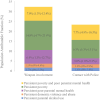Impact of family childhood adversity on risk of violence and involvement with police in adolescence: findings from the UK Millennium Cohort Study
- PMID: 39837611
- PMCID: PMC12171507
- DOI: 10.1136/jech-2024-223168
Impact of family childhood adversity on risk of violence and involvement with police in adolescence: findings from the UK Millennium Cohort Study
Abstract
Background: Childhood adversities, such as exposure to parental mental illness, domestic violence and abuse, substance use, and family poverty, have been linked to involvement in violence in early adulthood. However, evidence on the cumulative impact of multiple adversities throughout childhood on violence and crime in adolescence remains scarce. This study investigates the associations between trajectories of family adversity and poverty during childhood, and the risk of involvement in violence and contact with police in adolescence.
Methods: We used longitudinal data from the UK Millennium Cohort Study on 9316 children. Exposure trajectories of family adversities and poverty were characterised (from ages 0-14 years) using group-based multi-trajectory models. The outcomes were weapon involvement, for example, carrying a knife, and police contact measured at age 17 years. Odds ratios and 95% confidence intervals (OR, 95% CI) and population attributable fractions were estimated using logistic regression models, adjusting for confounding factors.
Results: The prevalence of weapon involvement and contact with police at age 17 years were 6.1% and 20.0%, respectively. Compared with children who experienced low poverty and family adversity throughout childhood, those exposed to persistent poverty and poor parental mental health were at notably increased risk of carrying weapons (adjusted OR (aOR) 2.2, 95% CI 1.3 to 3.6) and reporting contact with police (aOR 2.1, 95% CI 1.6 to 2.8). We estimate that about 32% of weapon involvement and 23% of contact with police at age 17 were attributable to persistent poverty and family adversity.
Conclusion: Exposure to poverty and poor parental mental health throughout childhood doubles the risk of weapon involvement and police contact in early adulthood. These findings emphasise the importance of lifecourse and anti-poverty approaches to reducing involvement in crime in the UK.
Keywords: ADOLESCENT; CLUSTER ANALYSIS; COHORT STUDIES; POVERTY.
© Author(s) (or their employer(s)) 2025. Re-use permitted under CC BY. Published by BMJ Group.
Conflict of interest statement
Competing interests: None declared.
Figures




Similar articles
-
Prevalence and Risk Factors of Gang Membership in a Brazilian Birth Cohort.JAMA Netw Open. 2024 Oct 1;7(10):e2440393. doi: 10.1001/jamanetworkopen.2024.40393. JAMA Netw Open. 2024. PMID: 39432305 Free PMC article.
-
Examining lifestyle factors as potential moderators of the link between childhood adversity and comorbid psychological distress and obesity in early adulthood.BMC Public Health. 2025 Jul 7;25(1):2403. doi: 10.1186/s12889-025-23505-6. BMC Public Health. 2025. PMID: 40624482 Free PMC article.
-
Impact of child socioemotional and cognitive development on exam results in adolescence: findings from the UK Millennium Cohort Study.Arch Dis Child. 2025 Jul 18;110(8):645-650. doi: 10.1136/archdischild-2024-327963. Arch Dis Child. 2025. PMID: 39929708 Free PMC article.
-
A revised and extended systematic review and meta-analysis of the relationship between childhood adversity and adult psychiatric disorder.J Psychiatr Res. 2022 Dec;156:268-283. doi: 10.1016/j.jpsychires.2022.10.015. Epub 2022 Oct 10. J Psychiatr Res. 2022. PMID: 36274532
-
Prevalence and odds of anxiety and depression in cutaneous malignant melanoma: a proportional meta-analysis and regression.Br J Dermatol. 2024 Jun 20;191(1):24-35. doi: 10.1093/bjd/ljae011. Br J Dermatol. 2024. PMID: 38197404
References
-
- Barrett S, Muir C, Burns S, et al. Interventions to Reduce Parental Substance Use, Domestic Violence and Mental Health Problems, and Their Impacts Upon Children’s Well-Being: A Systematic Review of Reviews and Evidence Mapping. Trauma Violence Abuse. 2024;25:393–412. doi: 10.1177/15248380231153867. - DOI - PMC - PubMed
MeSH terms
LinkOut - more resources
Full Text Sources
